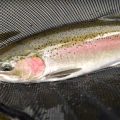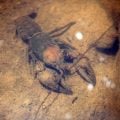How to Tie a Margaree Bug
Producer: Tim Flagler
Nova Scotia’s Cape Breton Island has a special place in my heart. As a kid, I got to spend a fair bit of time there, camping with my family. That’s me draped over my dad’s shoulders. During summer vacations, we’d erect a small tent city in a field on a relative’s farm, just off the Cabot Trail. Even at the tender age of 6, I couldn’t get enough of the place, and it was nearly impossible to keep me out of the water. Yeah, I might’ve put on a few pounds since then.
And not unlike a salmon, I’ve found myself migrating annually back to Cape Breton, and I still can’t stay out of the water. Now, it’s the Margaree River. My trips usually take place in the late fall toward the end of the Atlantic Salmon season. I go with a few guys who were once perfect strangers but now are good friends. We always have a spectacular time, regardless of conditions.
One of these years, I’m going to make it back up there earlier in the season when salmon are more likely to take bugs off the water’s surface. As a result, wet flies swung close to the surface, can be productive. Flies tied on with a riffling hitch tend to skim on the water’s surface rather than below it and can be particularly effective. As I understand it from my friends at The New Fly Fisher, follows and heart-stopping misses are a fairly regular occurrence, although certainly frustrating.
A great fly for the summer season, that can be fished either with or without a riffling hitch, is the Margaree Bug. As compared to many other Atlantic Salmon flies, it’s super easy to tie.
The fly starts with an extra heavy streamer hook in sizes from 4 to 8 – here, a Mustad 9671 in size 8.
For thread, I’ve loaded a bobbin with a spool of UTC black 70 Denier. Get the thread started on the hook shank behind the eye and, after taking a few wraps rearward, snip off the excess tag. Continue taking wraps down the hook shank to build up a thread base that goes all the way to the start of the bend. Then take a few wraps back up the shank so your thread hangs about halfway between the hook point and the barb.
Fine, olive chenille is the first material to be tied in. On this size 8 hook, a card-width length is plenty. Strip some of the fuzzy fibers from one end to expose the string core. Lay the string core against the near side of the hook and give your bobbin a counterclockwise spin, from the perspective of looking down on it. On the first wrap, your thread should want to jump rearward and catch that string core. Make sure the chenille is bound down well, then advance your tying thread forward to about 2/3rds of the way down the hook shank. Start taking touching wraps with the chenille. This will be the first of three equal-length chenille segments going up the shank. Here, I’ve done five wraps. With the wraps complete, anchor the chenille with a few tight turns of tying thread then snip the excess off close. Once again strip the fluffy fibers from the string core then continue to anchor the core with thread wraps.
Now, do basically the same thing with a card-width segment of the same size wine-colored chenille. Again, the idea is to create three equal-length segments of wrapped chenille that cover the entire hook shank. Binding down only the string core makes the fly more durable and helps to keep lumps and bumps to a minimum.
Go back to the olive chenille for the last segment. For whatever reason, my third segment looks a little longer than the other two, but that’s easily corrected by taking thread wraps back into it just a bit. The body of the fly should now look something like this. Trimming the top of the fly will help the wing to lay a bit more flat, rather than kick up.
Although flash is optional with the Margaree Bug, a couple of strands of pearl Krystal Flash really help to enliven the pattern. Find the midpoint of two strands and bind it to the top of the hook shank with wraps of tying thread. Fold the forward-pointing portion back and bind it down, so you’re left with four rearward-pointing strands. Take thread wraps to clean up and smooth out the head area. Trim the flash off even with the back edge of the hook bend.
Moose body hair is used to create the overwing of the fly. Snip a very small clump free from the hide, like less than 20 hairs. Strip out the fluffy underfur and any short hairs. Place the hair tips first into a stacker and give it a gentle stacking to align the tips. In the end, you really only want about a dozen hairs. Measure to form a wing that extends to the back edge of the hook bend. Grip the hair in the fingertips of your left hand and, while bracing your tying scissors behind the hook eye, snip the excess butt ends off square. Here too, give your bobbin a counterclockwise spin so the first wrap of thread will jump rearward and catch those butt ends. Moose body hair can be quite slippery so it’s a good idea to apply a coat of wax to your tying thread before binding the hair down. Well, better late than never. The wax definitely helps to keep your tying thread from wanting to slide down to the eye.
A single feather from a Green Highlander hen neck is used for the collar of the fly. Find a good-looking feather with fibers that are about half a hook shank in length. Strip off the lower fibers so you’re left with just the smaller ones towards the feather’s tip. With the shiny side of the feather facing you, gently preen the lower fibers down to expose the very tip of the feather. Snip this tip off, leaving a small triangular-shaped tie-in anchor. Place the anchor against the near side of the hook and take thread wraps to secure it. I probably should’ve used some thread wax here as well. Anyway, reach for your favorite pair of hackle pliers and use them to get hold of the feather’s stem. Bend the stem down through your fingertips as you preen the fibers rearward. Start taking wraps with the feather to produce a fairly sparse collar on the fly. In other words, like 1 1/2 – 2 turns. When you get to bare stem, use your tying thread to firmly anchor it, then snip the excess and any wayward fibers off close.
At this point, I’m definitely going to reach for some fly tier’s wax and give my thread an ample coating. This makes it much easier to sweep the hackle fibers rearward and use my tying thread to create a nice little head on the fly. End with your thread right at the base of the wing.
Get hold of your whip finish tool and use it to do a 5 or 6 turn, back to front, whip finish then seat the knot well and snip or cut your tying thread free. A coating or two or maybe even three of head cement or here, Sally Hansen Hard as Nails, applied to the thread wraps and allowed to sink in, will ensure they don’t come unraveled and that none of the material will pull out.
And that’s the Margaree Bug. All set to draw salmon up from the deep for a tremendous surface take. I definitely need to get back to the Margaree in the summer as well as the fall.
How to Tie a March Brown Emerger
How to Tie a Matt's Gnat











